ACC621, University: Technology in Audit Engagements Report
VerifiedAdded on 2022/10/31
|10
|2057
|236
Report
AI Summary
This report, prepared by a student, examines the impact of technology on audit engagements, particularly focusing on artificial intelligence, data analytics, and blockchain. The report begins with an email exchange between senior and intermediate auditors discussing the evolving role of auditors in the face of technological advancements. It then details the rationale behind the analysis, highlighting the increasing importance of technology in modern business environments and its influence on audit firms. The report analyzes how these technologies can improve efficiency, enhance accuracy, and mitigate risks within audit processes. It also explores the potential for these technologies to change the traditional auditing system and the human skills required for the profession. The report concludes with a discussion on how data analytics can benefit audit firms and how technology can increase communication within audit teams, ultimately supporting auditors in their decision-making processes. The report also references relevant academic articles to support its arguments.
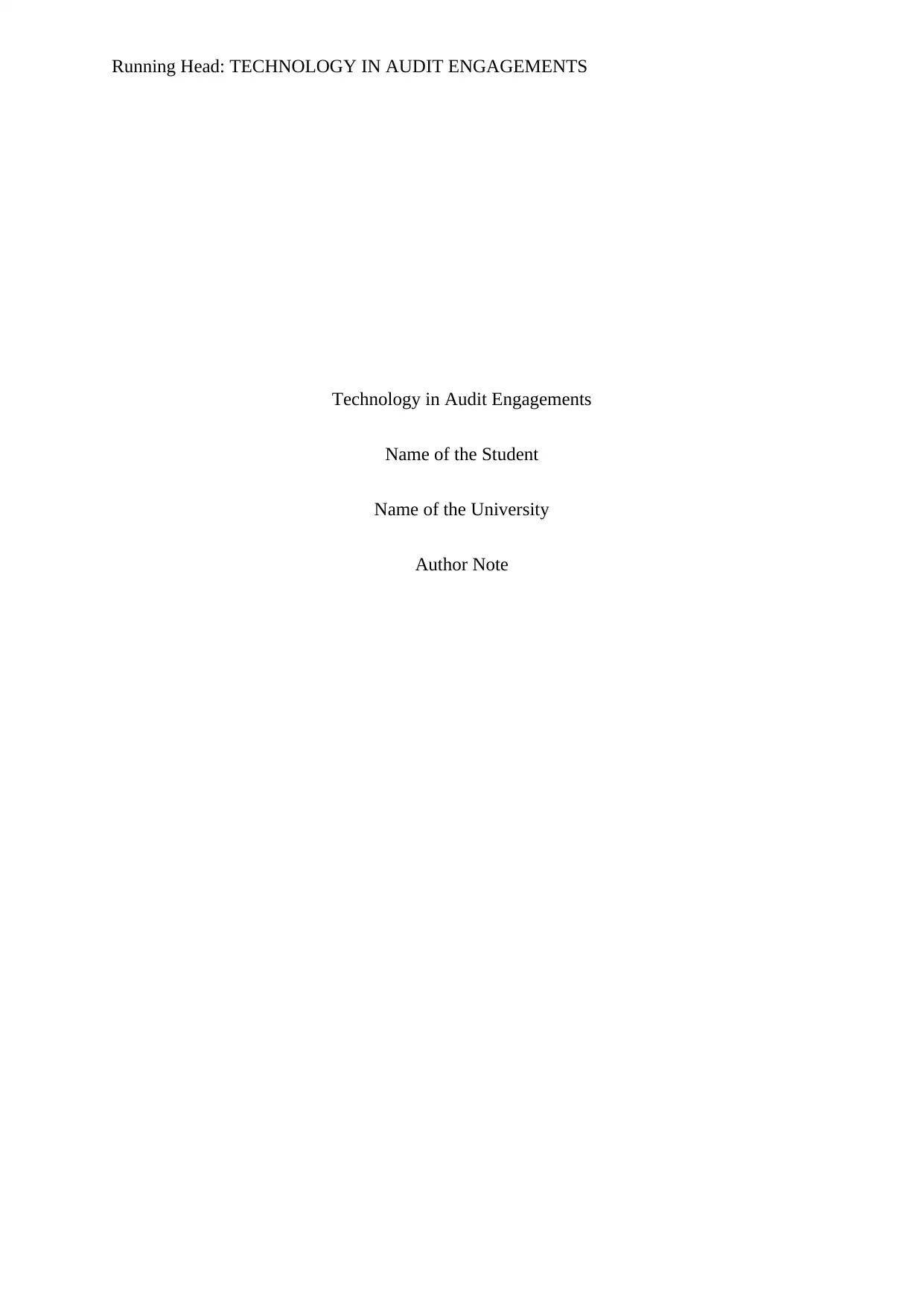
Running Head: TECHNOLOGY IN AUDIT ENGAGEMENTS
Technology in Audit Engagements
Name of the Student
Name of the University
Author Note
Technology in Audit Engagements
Name of the Student
Name of the University
Author Note
Paraphrase This Document
Need a fresh take? Get an instant paraphrase of this document with our AI Paraphraser
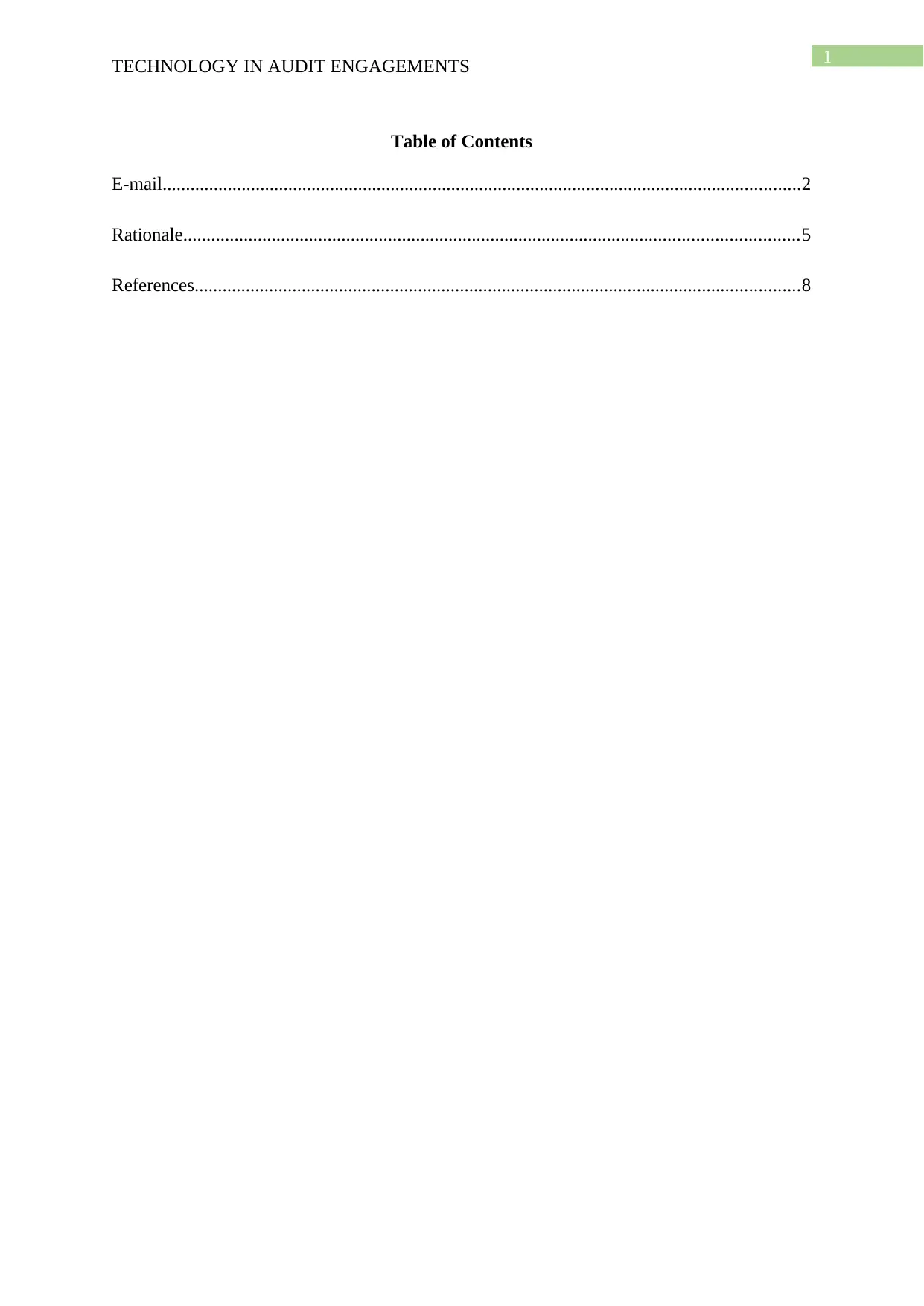
1
TECHNOLOGY IN AUDIT ENGAGEMENTS
Table of Contents
E-mail.........................................................................................................................................2
Rationale....................................................................................................................................5
References..................................................................................................................................8
TECHNOLOGY IN AUDIT ENGAGEMENTS
Table of Contents
E-mail.........................................................................................................................................2
Rationale....................................................................................................................................5
References..................................................................................................................................8
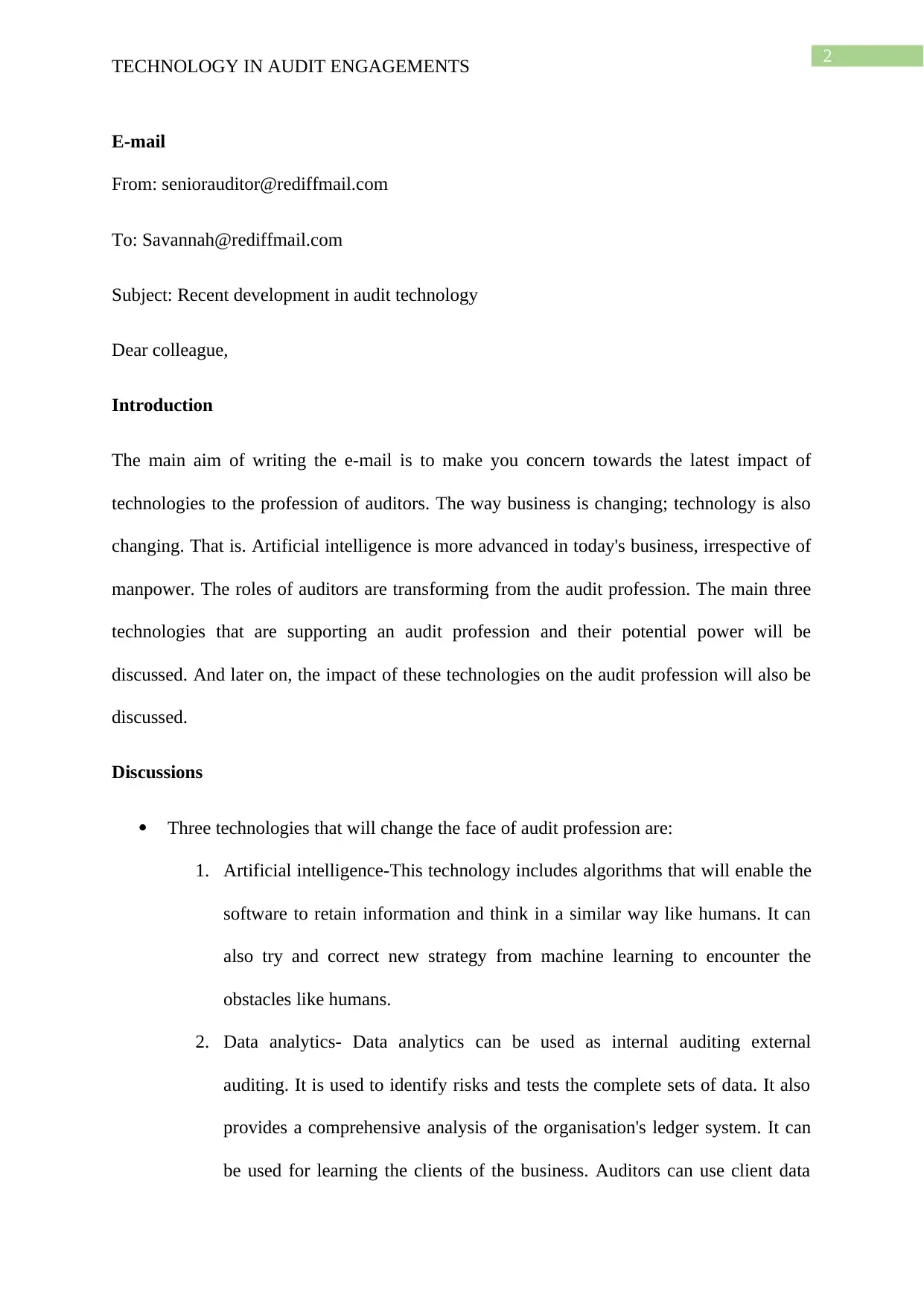
2
TECHNOLOGY IN AUDIT ENGAGEMENTS
E-mail
From: seniorauditor@rediffmail.com
To: Savannah@rediffmail.com
Subject: Recent development in audit technology
Dear colleague,
Introduction
The main aim of writing the e-mail is to make you concern towards the latest impact of
technologies to the profession of auditors. The way business is changing; technology is also
changing. That is. Artificial intelligence is more advanced in today's business, irrespective of
manpower. The roles of auditors are transforming from the audit profession. The main three
technologies that are supporting an audit profession and their potential power will be
discussed. And later on, the impact of these technologies on the audit profession will also be
discussed.
Discussions
Three technologies that will change the face of audit profession are:
1. Artificial intelligence-This technology includes algorithms that will enable the
software to retain information and think in a similar way like humans. It can
also try and correct new strategy from machine learning to encounter the
obstacles like humans.
2. Data analytics- Data analytics can be used as internal auditing external
auditing. It is used to identify risks and tests the complete sets of data. It also
provides a comprehensive analysis of the organisation's ledger system. It can
be used for learning the clients of the business. Auditors can use client data
TECHNOLOGY IN AUDIT ENGAGEMENTS
From: seniorauditor@rediffmail.com
To: Savannah@rediffmail.com
Subject: Recent development in audit technology
Dear colleague,
Introduction
The main aim of writing the e-mail is to make you concern towards the latest impact of
technologies to the profession of auditors. The way business is changing; technology is also
changing. That is. Artificial intelligence is more advanced in today's business, irrespective of
manpower. The roles of auditors are transforming from the audit profession. The main three
technologies that are supporting an audit profession and their potential power will be
discussed. And later on, the impact of these technologies on the audit profession will also be
discussed.
Discussions
Three technologies that will change the face of audit profession are:
1. Artificial intelligence-This technology includes algorithms that will enable the
software to retain information and think in a similar way like humans. It can
also try and correct new strategy from machine learning to encounter the
obstacles like humans.
2. Data analytics- Data analytics can be used as internal auditing external
auditing. It is used to identify risks and tests the complete sets of data. It also
provides a comprehensive analysis of the organisation's ledger system. It can
be used for learning the clients of the business. Auditors can use client data
⊘ This is a preview!⊘
Do you want full access?
Subscribe today to unlock all pages.

Trusted by 1+ million students worldwide
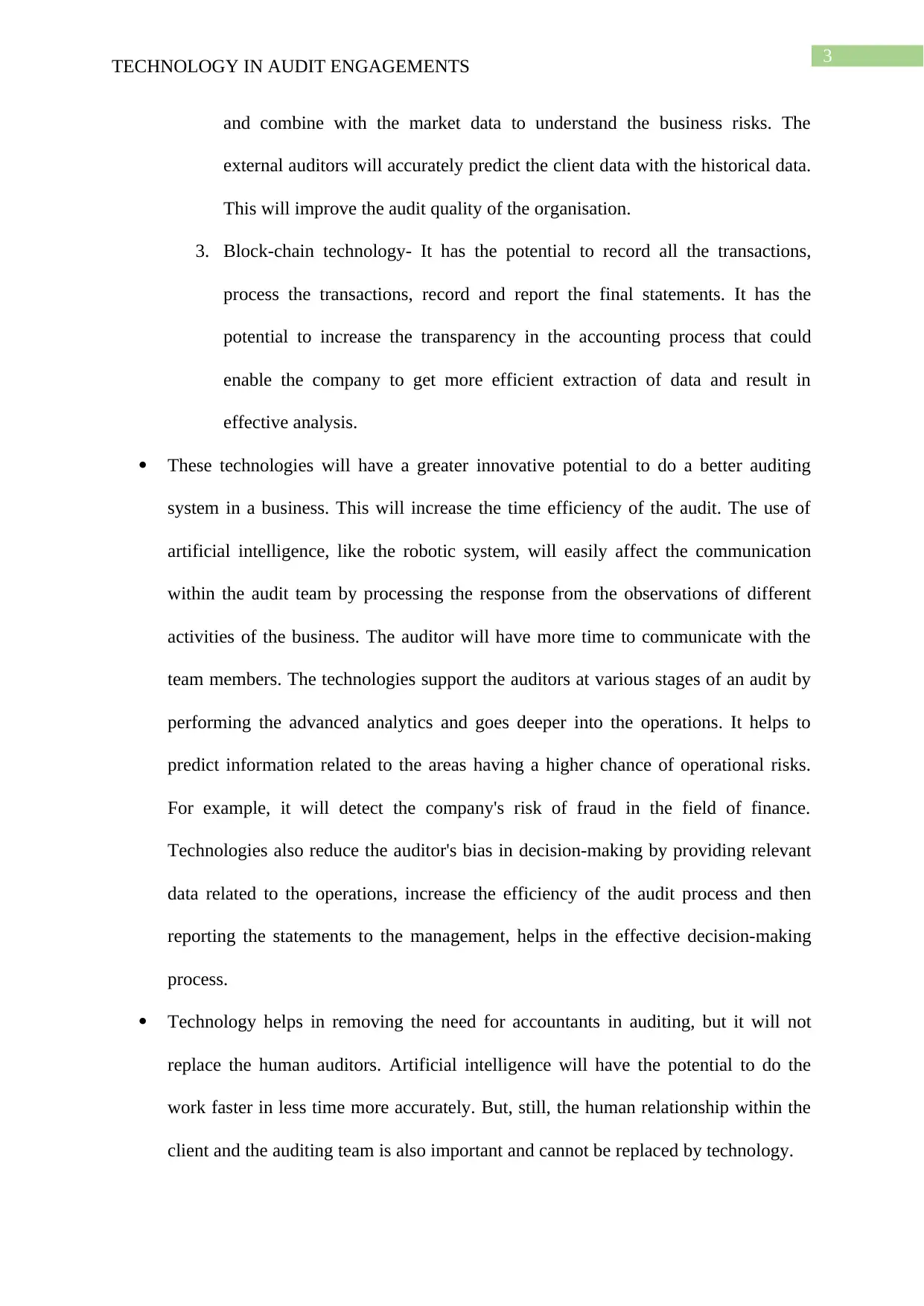
3
TECHNOLOGY IN AUDIT ENGAGEMENTS
and combine with the market data to understand the business risks. The
external auditors will accurately predict the client data with the historical data.
This will improve the audit quality of the organisation.
3. Block-chain technology- It has the potential to record all the transactions,
process the transactions, record and report the final statements. It has the
potential to increase the transparency in the accounting process that could
enable the company to get more efficient extraction of data and result in
effective analysis.
These technologies will have a greater innovative potential to do a better auditing
system in a business. This will increase the time efficiency of the audit. The use of
artificial intelligence, like the robotic system, will easily affect the communication
within the audit team by processing the response from the observations of different
activities of the business. The auditor will have more time to communicate with the
team members. The technologies support the auditors at various stages of an audit by
performing the advanced analytics and goes deeper into the operations. It helps to
predict information related to the areas having a higher chance of operational risks.
For example, it will detect the company's risk of fraud in the field of finance.
Technologies also reduce the auditor's bias in decision-making by providing relevant
data related to the operations, increase the efficiency of the audit process and then
reporting the statements to the management, helps in the effective decision-making
process.
Technology helps in removing the need for accountants in auditing, but it will not
replace the human auditors. Artificial intelligence will have the potential to do the
work faster in less time more accurately. But, still, the human relationship within the
client and the auditing team is also important and cannot be replaced by technology.
TECHNOLOGY IN AUDIT ENGAGEMENTS
and combine with the market data to understand the business risks. The
external auditors will accurately predict the client data with the historical data.
This will improve the audit quality of the organisation.
3. Block-chain technology- It has the potential to record all the transactions,
process the transactions, record and report the final statements. It has the
potential to increase the transparency in the accounting process that could
enable the company to get more efficient extraction of data and result in
effective analysis.
These technologies will have a greater innovative potential to do a better auditing
system in a business. This will increase the time efficiency of the audit. The use of
artificial intelligence, like the robotic system, will easily affect the communication
within the audit team by processing the response from the observations of different
activities of the business. The auditor will have more time to communicate with the
team members. The technologies support the auditors at various stages of an audit by
performing the advanced analytics and goes deeper into the operations. It helps to
predict information related to the areas having a higher chance of operational risks.
For example, it will detect the company's risk of fraud in the field of finance.
Technologies also reduce the auditor's bias in decision-making by providing relevant
data related to the operations, increase the efficiency of the audit process and then
reporting the statements to the management, helps in the effective decision-making
process.
Technology helps in removing the need for accountants in auditing, but it will not
replace the human auditors. Artificial intelligence will have the potential to do the
work faster in less time more accurately. But, still, the human relationship within the
client and the auditing team is also important and cannot be replaced by technology.
Paraphrase This Document
Need a fresh take? Get an instant paraphrase of this document with our AI Paraphraser
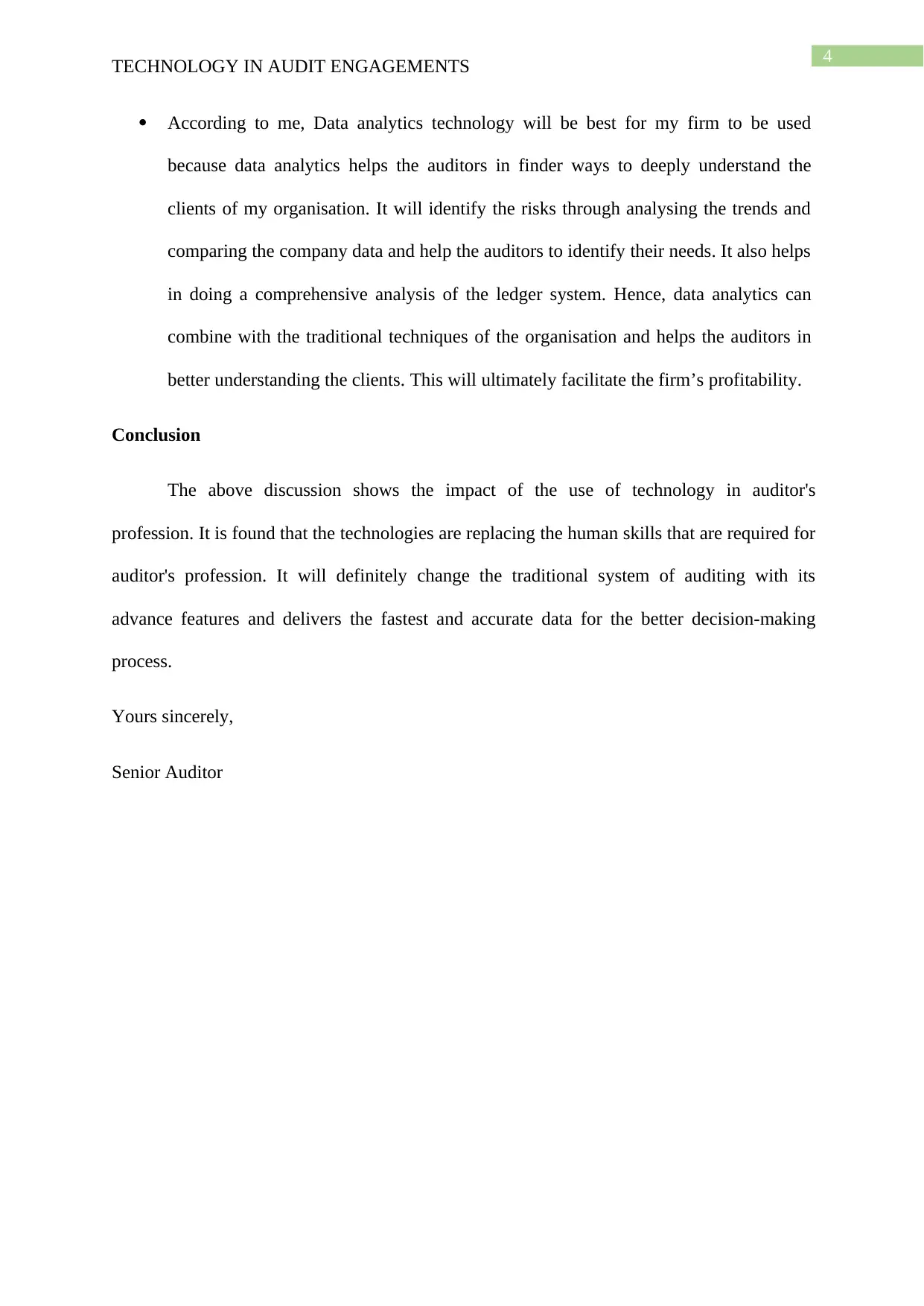
4
TECHNOLOGY IN AUDIT ENGAGEMENTS
According to me, Data analytics technology will be best for my firm to be used
because data analytics helps the auditors in finder ways to deeply understand the
clients of my organisation. It will identify the risks through analysing the trends and
comparing the company data and help the auditors to identify their needs. It also helps
in doing a comprehensive analysis of the ledger system. Hence, data analytics can
combine with the traditional techniques of the organisation and helps the auditors in
better understanding the clients. This will ultimately facilitate the firm’s profitability.
Conclusion
The above discussion shows the impact of the use of technology in auditor's
profession. It is found that the technologies are replacing the human skills that are required for
auditor's profession. It will definitely change the traditional system of auditing with its
advance features and delivers the fastest and accurate data for the better decision-making
process.
Yours sincerely,
Senior Auditor
TECHNOLOGY IN AUDIT ENGAGEMENTS
According to me, Data analytics technology will be best for my firm to be used
because data analytics helps the auditors in finder ways to deeply understand the
clients of my organisation. It will identify the risks through analysing the trends and
comparing the company data and help the auditors to identify their needs. It also helps
in doing a comprehensive analysis of the ledger system. Hence, data analytics can
combine with the traditional techniques of the organisation and helps the auditors in
better understanding the clients. This will ultimately facilitate the firm’s profitability.
Conclusion
The above discussion shows the impact of the use of technology in auditor's
profession. It is found that the technologies are replacing the human skills that are required for
auditor's profession. It will definitely change the traditional system of auditing with its
advance features and delivers the fastest and accurate data for the better decision-making
process.
Yours sincerely,
Senior Auditor
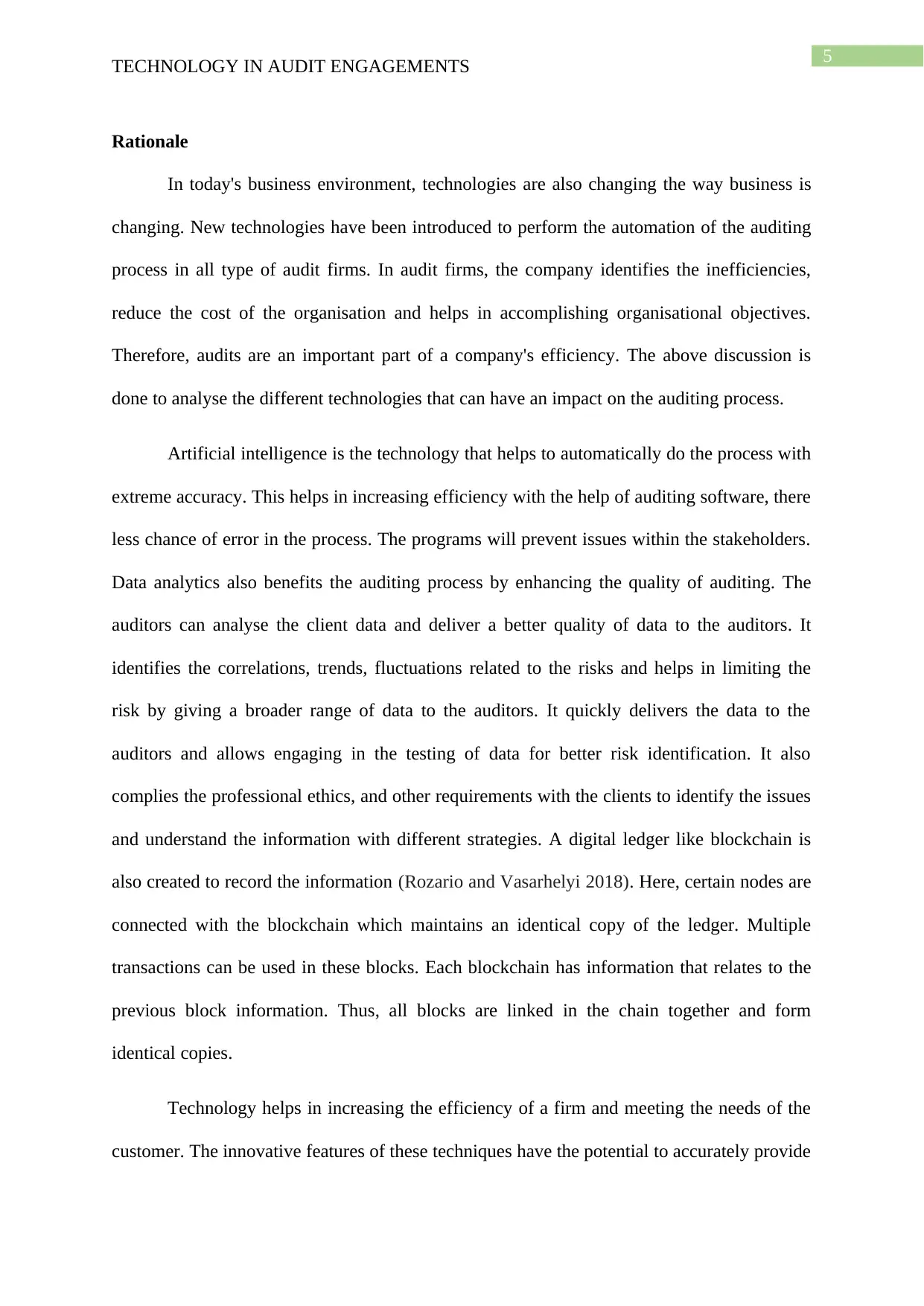
5
TECHNOLOGY IN AUDIT ENGAGEMENTS
Rationale
In today's business environment, technologies are also changing the way business is
changing. New technologies have been introduced to perform the automation of the auditing
process in all type of audit firms. In audit firms, the company identifies the inefficiencies,
reduce the cost of the organisation and helps in accomplishing organisational objectives.
Therefore, audits are an important part of a company's efficiency. The above discussion is
done to analyse the different technologies that can have an impact on the auditing process.
Artificial intelligence is the technology that helps to automatically do the process with
extreme accuracy. This helps in increasing efficiency with the help of auditing software, there
less chance of error in the process. The programs will prevent issues within the stakeholders.
Data analytics also benefits the auditing process by enhancing the quality of auditing. The
auditors can analyse the client data and deliver a better quality of data to the auditors. It
identifies the correlations, trends, fluctuations related to the risks and helps in limiting the
risk by giving a broader range of data to the auditors. It quickly delivers the data to the
auditors and allows engaging in the testing of data for better risk identification. It also
complies the professional ethics, and other requirements with the clients to identify the issues
and understand the information with different strategies. A digital ledger like blockchain is
also created to record the information (Rozario and Vasarhelyi 2018). Here, certain nodes are
connected with the blockchain which maintains an identical copy of the ledger. Multiple
transactions can be used in these blocks. Each blockchain has information that relates to the
previous block information. Thus, all blocks are linked in the chain together and form
identical copies.
Technology helps in increasing the efficiency of a firm and meeting the needs of the
customer. The innovative features of these techniques have the potential to accurately provide
TECHNOLOGY IN AUDIT ENGAGEMENTS
Rationale
In today's business environment, technologies are also changing the way business is
changing. New technologies have been introduced to perform the automation of the auditing
process in all type of audit firms. In audit firms, the company identifies the inefficiencies,
reduce the cost of the organisation and helps in accomplishing organisational objectives.
Therefore, audits are an important part of a company's efficiency. The above discussion is
done to analyse the different technologies that can have an impact on the auditing process.
Artificial intelligence is the technology that helps to automatically do the process with
extreme accuracy. This helps in increasing efficiency with the help of auditing software, there
less chance of error in the process. The programs will prevent issues within the stakeholders.
Data analytics also benefits the auditing process by enhancing the quality of auditing. The
auditors can analyse the client data and deliver a better quality of data to the auditors. It
identifies the correlations, trends, fluctuations related to the risks and helps in limiting the
risk by giving a broader range of data to the auditors. It quickly delivers the data to the
auditors and allows engaging in the testing of data for better risk identification. It also
complies the professional ethics, and other requirements with the clients to identify the issues
and understand the information with different strategies. A digital ledger like blockchain is
also created to record the information (Rozario and Vasarhelyi 2018). Here, certain nodes are
connected with the blockchain which maintains an identical copy of the ledger. Multiple
transactions can be used in these blocks. Each blockchain has information that relates to the
previous block information. Thus, all blocks are linked in the chain together and form
identical copies.
Technology helps in increasing the efficiency of a firm and meeting the needs of the
customer. The innovative features of these techniques have the potential to accurately provide
⊘ This is a preview!⊘
Do you want full access?
Subscribe today to unlock all pages.

Trusted by 1+ million students worldwide

6
TECHNOLOGY IN AUDIT ENGAGEMENTS
relevant information to the auditors and help in increasing the business performance (Chan
and Vasarhelyi 2012). Auditors are involved in calculating the performance of the employee
of an organisation. Technologies help in calculating the employee retention value of an
organisation. These innovative features of technology increase the organisational standard.
Traditionally the mitigation of risk was very low, but with the innovative features of
technologies helps in minimising the risks by mitigating a very high level of risks
(Rikhardsson and Dull 2016). Auditors and organisations can combine traditional methods
and technologies to increase the quality of auditing. The technologies with a greater extent
can be entirely replaced with the manpower. The capability of artificial intelligence is so high
that it can undergo machine learning and allow the software to perform human-related tasks.
There are certain tasks in auditing where the work is to be performed repeatedly. The new
technologies and software can help the human auditors, and the human will have the power to
determine how much work an artificial intelligence will need to do.
The most important technology that can be useful for any audit firms is found to be
Data analytics. Data analytics will rely on daily transactions of companies operation and
check the irregularities and identifies the other errors more accurately (Earley 2015). The
traditional function system of auditing has been replaced. Today, the role of financial
reporting, controlling the risks, solving the complexity of the problems, reducing the costs are
very challenging for the auditors. These factors give quality information to the auditors and
help the management in better decision-making. The effectiveness of decision-making
ultimately increases business performance. Today's business environment is facilitating
towards developing the organisational structure. A healthy business environment will reduce
the issues within the audit team, and the accountability of the flow of information is effective.
The internal auditors have time to focus more on risk-based auditing systems. The technology
also allows the auditors to deliver more strategic value by lowering the costs of operation.
TECHNOLOGY IN AUDIT ENGAGEMENTS
relevant information to the auditors and help in increasing the business performance (Chan
and Vasarhelyi 2012). Auditors are involved in calculating the performance of the employee
of an organisation. Technologies help in calculating the employee retention value of an
organisation. These innovative features of technology increase the organisational standard.
Traditionally the mitigation of risk was very low, but with the innovative features of
technologies helps in minimising the risks by mitigating a very high level of risks
(Rikhardsson and Dull 2016). Auditors and organisations can combine traditional methods
and technologies to increase the quality of auditing. The technologies with a greater extent
can be entirely replaced with the manpower. The capability of artificial intelligence is so high
that it can undergo machine learning and allow the software to perform human-related tasks.
There are certain tasks in auditing where the work is to be performed repeatedly. The new
technologies and software can help the human auditors, and the human will have the power to
determine how much work an artificial intelligence will need to do.
The most important technology that can be useful for any audit firms is found to be
Data analytics. Data analytics will rely on daily transactions of companies operation and
check the irregularities and identifies the other errors more accurately (Earley 2015). The
traditional function system of auditing has been replaced. Today, the role of financial
reporting, controlling the risks, solving the complexity of the problems, reducing the costs are
very challenging for the auditors. These factors give quality information to the auditors and
help the management in better decision-making. The effectiveness of decision-making
ultimately increases business performance. Today's business environment is facilitating
towards developing the organisational structure. A healthy business environment will reduce
the issues within the audit team, and the accountability of the flow of information is effective.
The internal auditors have time to focus more on risk-based auditing systems. The technology
also allows the auditors to deliver more strategic value by lowering the costs of operation.
Paraphrase This Document
Need a fresh take? Get an instant paraphrase of this document with our AI Paraphraser
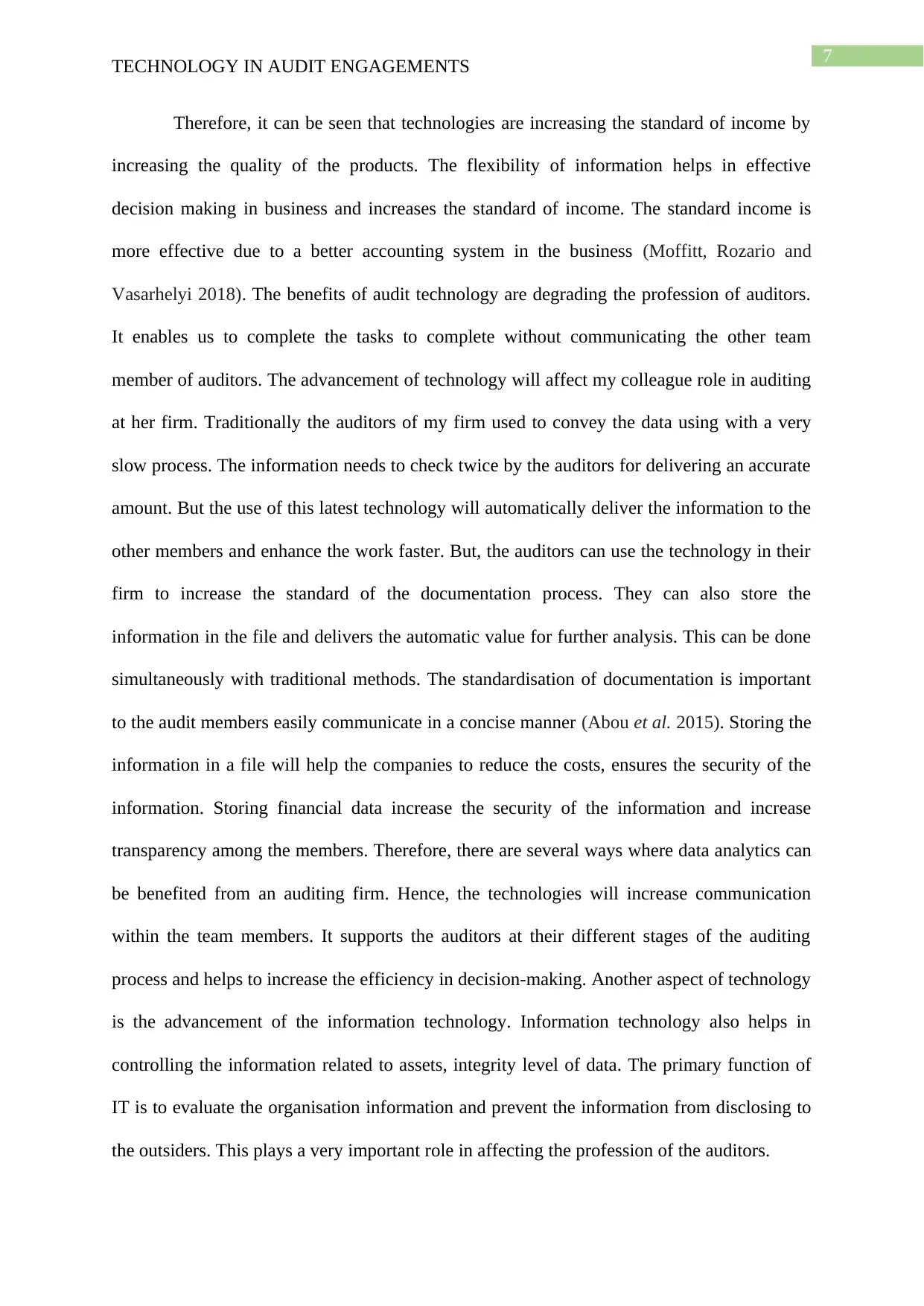
7
TECHNOLOGY IN AUDIT ENGAGEMENTS
Therefore, it can be seen that technologies are increasing the standard of income by
increasing the quality of the products. The flexibility of information helps in effective
decision making in business and increases the standard of income. The standard income is
more effective due to a better accounting system in the business (Moffitt, Rozario and
Vasarhelyi 2018). The benefits of audit technology are degrading the profession of auditors.
It enables us to complete the tasks to complete without communicating the other team
member of auditors. The advancement of technology will affect my colleague role in auditing
at her firm. Traditionally the auditors of my firm used to convey the data using with a very
slow process. The information needs to check twice by the auditors for delivering an accurate
amount. But the use of this latest technology will automatically deliver the information to the
other members and enhance the work faster. But, the auditors can use the technology in their
firm to increase the standard of the documentation process. They can also store the
information in the file and delivers the automatic value for further analysis. This can be done
simultaneously with traditional methods. The standardisation of documentation is important
to the audit members easily communicate in a concise manner (Abou et al. 2015). Storing the
information in a file will help the companies to reduce the costs, ensures the security of the
information. Storing financial data increase the security of the information and increase
transparency among the members. Therefore, there are several ways where data analytics can
be benefited from an auditing firm. Hence, the technologies will increase communication
within the team members. It supports the auditors at their different stages of the auditing
process and helps to increase the efficiency in decision-making. Another aspect of technology
is the advancement of the information technology. Information technology also helps in
controlling the information related to assets, integrity level of data. The primary function of
IT is to evaluate the organisation information and prevent the information from disclosing to
the outsiders. This plays a very important role in affecting the profession of the auditors.
TECHNOLOGY IN AUDIT ENGAGEMENTS
Therefore, it can be seen that technologies are increasing the standard of income by
increasing the quality of the products. The flexibility of information helps in effective
decision making in business and increases the standard of income. The standard income is
more effective due to a better accounting system in the business (Moffitt, Rozario and
Vasarhelyi 2018). The benefits of audit technology are degrading the profession of auditors.
It enables us to complete the tasks to complete without communicating the other team
member of auditors. The advancement of technology will affect my colleague role in auditing
at her firm. Traditionally the auditors of my firm used to convey the data using with a very
slow process. The information needs to check twice by the auditors for delivering an accurate
amount. But the use of this latest technology will automatically deliver the information to the
other members and enhance the work faster. But, the auditors can use the technology in their
firm to increase the standard of the documentation process. They can also store the
information in the file and delivers the automatic value for further analysis. This can be done
simultaneously with traditional methods. The standardisation of documentation is important
to the audit members easily communicate in a concise manner (Abou et al. 2015). Storing the
information in a file will help the companies to reduce the costs, ensures the security of the
information. Storing financial data increase the security of the information and increase
transparency among the members. Therefore, there are several ways where data analytics can
be benefited from an auditing firm. Hence, the technologies will increase communication
within the team members. It supports the auditors at their different stages of the auditing
process and helps to increase the efficiency in decision-making. Another aspect of technology
is the advancement of the information technology. Information technology also helps in
controlling the information related to assets, integrity level of data. The primary function of
IT is to evaluate the organisation information and prevent the information from disclosing to
the outsiders. This plays a very important role in affecting the profession of the auditors.

8
TECHNOLOGY IN AUDIT ENGAGEMENTS
References
Abou‐El‐Sood, H., Kotb, A. and Allam, A., 2015. Exploring auditors' perceptions of the
usage and importance of audit information technology. International Journal of
Auditing, 19(3), pp.252-266.
Chan, D.Y. and Vasarhelyi, M.A., 2012. Innovation and practice of continuous
auditing. International Journal of Accounting Information Systems, 12(2), pp.152-160.
Earley, C.E., 2015. Data analytics in auditing: Opportunities and challenges. Business
Horizons, 58(5), pp.493-500.
Moffitt, K.C., Rozario, A.M. and Vasarhelyi, M.A., 2018. Robotic process automation for
auditing. Journal of Emerging Technologies in Accounting, 15(1), pp.1-10.
Rickhardson, P. and Dull, R., 2016. An exploratory study of the adoption, application and
impacts of continuous auditing technologies in small businesses. International Journal of
Accounting Information Systems, 20, pp.26-37.
Rozario, A.M. and Vasarhelyi, M.A., 2018. Auditing with Smart Contracts. International
Journal of Digital Accounting Research, 18.
TECHNOLOGY IN AUDIT ENGAGEMENTS
References
Abou‐El‐Sood, H., Kotb, A. and Allam, A., 2015. Exploring auditors' perceptions of the
usage and importance of audit information technology. International Journal of
Auditing, 19(3), pp.252-266.
Chan, D.Y. and Vasarhelyi, M.A., 2012. Innovation and practice of continuous
auditing. International Journal of Accounting Information Systems, 12(2), pp.152-160.
Earley, C.E., 2015. Data analytics in auditing: Opportunities and challenges. Business
Horizons, 58(5), pp.493-500.
Moffitt, K.C., Rozario, A.M. and Vasarhelyi, M.A., 2018. Robotic process automation for
auditing. Journal of Emerging Technologies in Accounting, 15(1), pp.1-10.
Rickhardson, P. and Dull, R., 2016. An exploratory study of the adoption, application and
impacts of continuous auditing technologies in small businesses. International Journal of
Accounting Information Systems, 20, pp.26-37.
Rozario, A.M. and Vasarhelyi, M.A., 2018. Auditing with Smart Contracts. International
Journal of Digital Accounting Research, 18.
⊘ This is a preview!⊘
Do you want full access?
Subscribe today to unlock all pages.

Trusted by 1+ million students worldwide
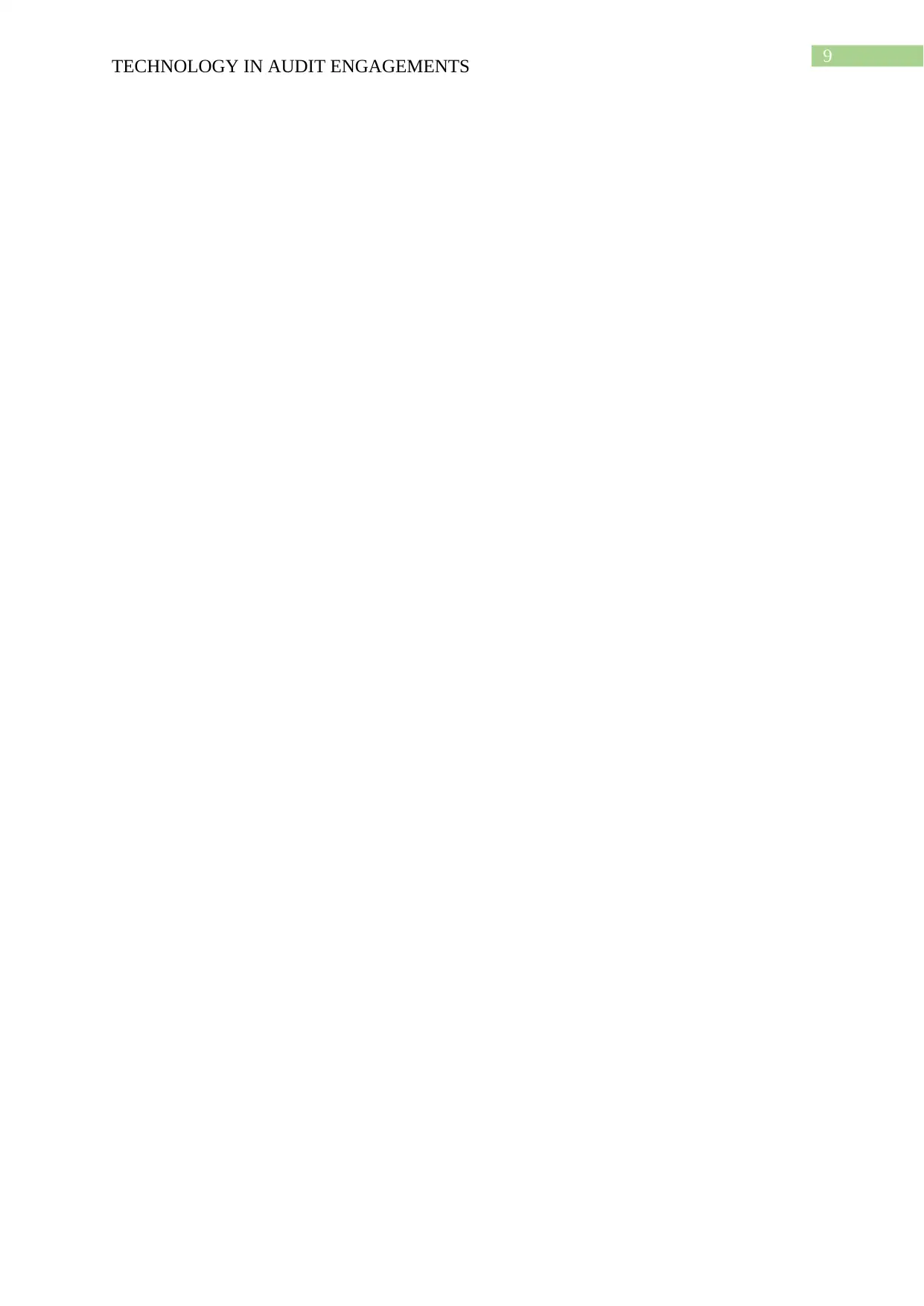
9
TECHNOLOGY IN AUDIT ENGAGEMENTS
TECHNOLOGY IN AUDIT ENGAGEMENTS
1 out of 10
Related Documents
Your All-in-One AI-Powered Toolkit for Academic Success.
+13062052269
info@desklib.com
Available 24*7 on WhatsApp / Email
![[object Object]](/_next/static/media/star-bottom.7253800d.svg)
Unlock your academic potential
Copyright © 2020–2025 A2Z Services. All Rights Reserved. Developed and managed by ZUCOL.





